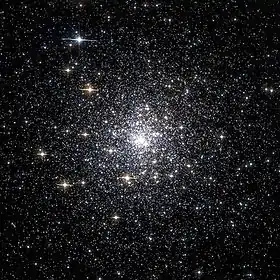< Messier Index
| Messier 70 | |
|---|---|
 M70 from w:Hubble Space Telescope; 3.32′ view Credit: w:NASA/w:STScI/w:WikiSky | |
| Observation data (w:J2000 epoch) | |
| Class | V |
| Constellation | Sagittarius |
| Right ascension | 18h 43m 12.64s[1] |
| Declination | -32° 17′ 30.8″[1] |
| Distance | 29.3 kly[citation needed] (9 kpc) |
| Apparent magnitude (V) | +9.06[1] |
| Apparent dimensions (V) | 8′.0 |
| Physical characteristics | |
| Mass | kg ( M) |
| Radius | 34 ly[2] |
| Other designations | M70, NGC 6681, GCl 101[1] |
Messier 70 (also known as M70 or NGC 6681) is a w:globular cluster in the w:constellation Sagittarius. It was discovered by w:Charles Messier in w:1780.
M70 is at a distance of about 29,300 w:light years away from w:Earth and close to the w:Galactic Center. It is roughly the same size and w:luminosity as its neighbour in space, w:Globular Cluster M69. Only 2 w:variable stars are known within this cluster.
External links
References
- 1 2 3 4 "SIMBAD Astronomical Database". Results for NGC 6681. http://simbad.u-strasbg.fr/Simbad. Retrieved 2006-11-17.
- ↑ distance × sin( diameter_angle / 2 ) = 34 ly. radius
| |||||
This article is issued from Wikibooks. The text is licensed under Creative Commons - Attribution - Sharealike. Additional terms may apply for the media files.